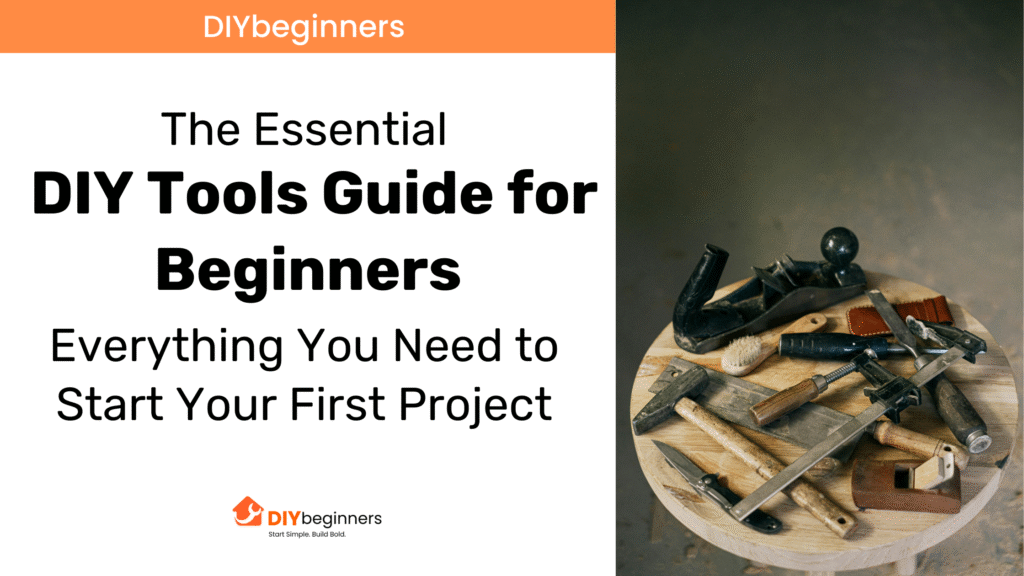
It can be not very safe to begin making your DIY projects when you see the line of tools in the hardware store that may seem daunting to sort through. You can not do without tools, but the question is which ones are worth spending your bucks on. The fact is, you don’t have to make purchases all at once. Obtaining the best DIY tools does not necessarily have to cost you a fortune, and with a good base, you will be able to conquer most home projects with an air of confidence.
Regardless of whether you are going to hang pictures, create some shelves, or deal with a larger home improvement, suitable tools are always great. This guide will outline in detail what you should consider when starting, the costs you should incur, and what tools should be prioritized in your shopping cart.
Essential Hand Tools: Building Your Foundation
Any DIYer must have a set of good hand tools before proceeding to power tools. These are starter tools that make up the core of any DIY toolbox and will get most of the initial projects done.
1. Measuring and Leveling Tools
The success of all your projects depends on measuring tools. A quality tape measure must be the first tool you buy -one that is 25 feet long with a sturdy case that will not break after a couple of drops. The numbers have to be big and easily readable, even in low light.
A spirit level is also of equal importance in any installation work. Your pictures will hang on the shelves and will go up ccrookedleaving a mark of amateur work. Most jobs can be done with a 24-inch level, but a smaller 12-inch level is ideal in locations with a limited amount of space. Laser spirit levels are more accurate, but not essential to users with h lower level of expertise.
2. Fastening and Assembly Tools
An adjustable screwdriver has a lot of interchangeable screwdriver bits and can help in saving time and relieving the hands of exhaustion over prolonged construction. Get sets with both Phillips and flathead bits in a variety of sizes, and maybe some basic hex bits to put furniture together.
Any toolset of the workshop must be equipped with a solid hammer.. Most uses warrant a 16-ounce claw hammer due to its unbalanced compromise of power and control. The claw end takes out nails and can even be used as leverage to be able to tear something down, so this is an extremely useful tool.
Pliers will vary in type, but a good place to start is with needle-nose pliers and standard slip-joint pliers. These are capable of most gripping, twisting, and wire-cutting jobs that you will get in home repairs.
3. Cutting and Finishing ToolsA A
Stanley knife with removable blades slices paper, drywall, and a whole lot more. Purchase spare blades – blunt blades are dangerous, as well as unable to make clean cuts.
When repairing walls and preparing them to be painted, a filling knife is used to smooth potentially rough areas of joint compound and rip off old caulk. It should have a soft blade that is not going to leave gouges on surfaces.
A caulking gun is one of those tools that people think is specialized, yet they use more than they imagine. Whether it is sealing bathroom fixtures or caulking windows, good caulking will help to prevent expensive water damage as well as make windows more energy efficient.
Budget Planning: Smart Tool Investment Strategies
1. Phase One: Essential Hand Tools ($75-125)
The basics include a hammer (15 dollars); multi-bit screwdriver set (20 dollars); adjustable wrench (12 dollars); tape measure (8 dollars), and basic pliers set (20 dollars). This foundation works on the majority of small repairs and assembly.
The utility knife (approximately $10), level (approximately $1),5 and basic safety gear (approximately $25) can be added to the basic toolset. This investment will take most of the simple chores around the house and most basic initiatives.
2. Phase Two: Power Tool Investment ($150-300)
A good electrical tool to get started with should be a cordless drill with two batteries (cost $80-150). With this one investment, you dramatically gain capacity in your projects, and not to mention the time savings on every task where screws or holes need to be created.
Next, and probably the most useful piece of equipment, is an orbital sander ($50-100) if you expect to do any refinishing or surface prep work. The benefits outweigh the price after only one furniture project because of the savings of time and effort.
3. Phase Three: Specialized Tools (As Needed)
Buy specialty tools only when you need to. A miter saw, jigsaw, or circular saw can be very useful in woodworking, but would cost you plenty in paper weights in home maintenance.
You may rent highly priced gear for one-time initiatives. Home centers will often allow you to rent tools by the day or week, relieving you of storing and maintaining them.
Getting Started: Your First Projects
1. Picture Hanging and Wall Mounting
This is a timeless novice project which requires the use of a level, drill, screwdriver, and measuring tools. Graduate starting with lighter things first, then proceed to heavier things. The lesson to learn before fastening the frames is to detect the existence of wall studs and select proper fastening materials to avoid repair jobs of the walls in the future.
2. Basic Furniture Assembly
Assembling furniture that comes in a flat-pack will train you to read instructions, work with various fasteners, and different materials. These starter tools speed up the work and give more accuracy than the basic tools that are typically provided with furniture kits to piece together.
3. Simple Shelf Installation
Installing shelves encompasses the skills of measuring, leveling, drilling, and fastening in a single project. Install simple bracket-mounted shelves first before trying floating shelves and built-in units.
4. Minor Repairs and Maintenance
Installing cabinet door stops, covering outlets with new covers, and applying caulking along the edges of fixtures are a few examples of practical building skills as well as home improvements. The projects help of which their abilities with the help of various tools and methods.
Building Confidence Through Practice
Any workshop tool must pay its way in your workshop by finding frequent work. Determining which tools and/or equipment are the best to include in your collection will depend on your projects and your interests, and issues.
You should train with the tools on waste materials before doing major projects. Knowing the way your drill drills in different substances, or the way your saw cuts pieces of different thickness, helps avoid flaws in finished work.
Make a tidy up of tools. A poorly taken care of tool will do worse and, consequently, have a shorter lifespan than an expensive tool that has been looked after. A practice can make simple tools maintenance second nature.
Moving Forward: Expanding Your Capabilities
These will be the best DIY tools you are going to need to make it through the next several years, but as your skill level increases, so do your needs. Watch what tasks annoy you or leave you with too much to do with the equipment you currently have in place. These are places to consider strategic improvements.
Connect to online DIY groups and your local workshop,,s where you can meet people to can teach you new tricks and guide you on the best tools to use. There is no better way to get to know product capabilities or functions than to see tools in use.
Good DIY power tools are a good investment even in the short run, don’tnot have to invest all at once. Taking your time to slowly acquire tools means you will just purchase something useful and not just another object in your garage.
Your Do-It-Yourself journey begins with your first purchase of a tool, but it is really about building the confidence to take a problem and solve it, and to better your living environment. Once you have the proper base of tools and a desire to learn, you will be surprised at what you can do.
